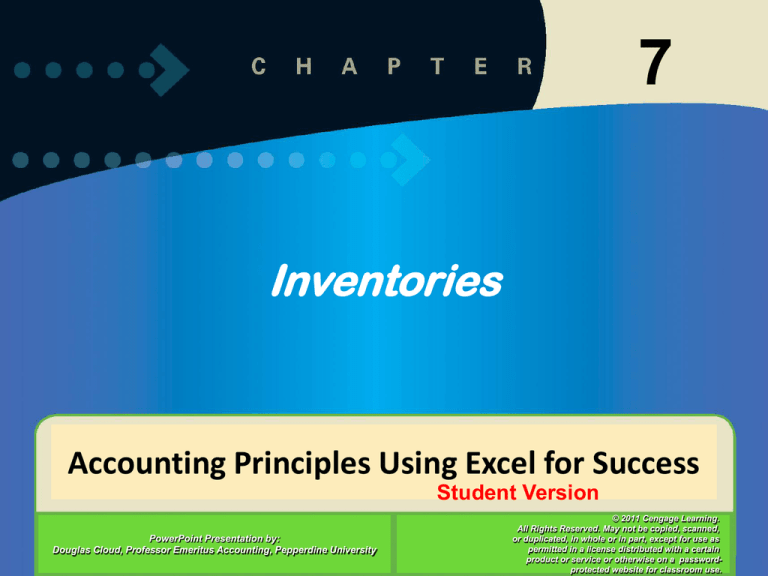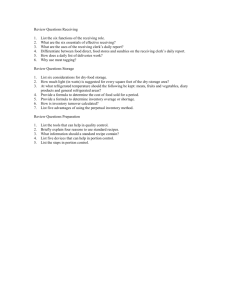
7
Inventories
Accounting Principles Using Excel for Success
7-1
PowerPoint Presentation by:
Douglas Cloud, Professor Emeritus Accounting, Pepperdine University
Student Version
© 2011 Cengage Learning.
All Rights Reserved. May not be copied, scanned,
or duplicated, in whole or in part, except for use as
permitted in a license distributed with a certain
product or service or otherwise on a passwordprotected website for classroom use.
1
Describe the
importance of control
over inventory.
7-2
1
Two primary objectives of
control over inventory are:
1. Safeguarding the inventory,
and
2. Properly reporting it in the
financial statements.
7-3
1
A physical inventory or count
of inventory should be taken
near year-end to make sure
that the quantity of inventory
reported in the financial
statements is accurate.
7-4
2
Describe the three inventory
cost flow assumptions and
how they impact the income
statement and balance
sheet.
7-5
7-5
2
Under the first-in, first out (FIFO)
inventory cost flow method, the
first units purchased are assumed to
be sold and the ending inventory is
made up of the most recent
purchases.
7-6
2
Under the last-in, first out (LIFO)
inventory cost flow method, the
last units purchased are assumed
to be sold first and the ending
inventory is made up of the first
units purchased.
7-7
2
Under the average inventory cost
flow method, the cost of the units
sold and in ending inventory is an
average of the purchase costs.
7-8
3
Determine the cost of
inventory under the
perpetual inventory system,
using the FIFO, LIFO, and
average cost methods.
7-9
7-9
3
First-In, First-Out Method
On January 1, the firm had 100 units
of Item 127B that cost $20 per unit.
Item 127B
Jan.
7-10
1
Inventory
Units
Cost
100
$20
3
First-In, First-Out Method
On January 4, the firm sold 70 units
of 127B at $30 each.
Item 127B
Jan.
7-11
1
4
Inventory
Sale
Units
Cost
100
70
$20
3
Exhibit 3
7-12
Entries and Perpetual Inventory Account (FIFO)
3
First-In, First-Out Method
On January 10, the firm purchased
80 units at $21 each.
Item 127B
Jan.
7-13
1
4
10
Inventory
Sale
Purchase
Units
Cost
100
70
80
$20
21
3
Exhibit 3
Entries and Perpetual Inventory
Account (FIFO) (continued)
10 Merchandise Inventory
Accounts Payable
Date
Jan. 1
7-14
1,680
1,680
3
First-In, First-Out Method
On January 22, the firm sold 40 units
for $30 each.
Item 127B
Jan.
7-15
1
4
10
22
Inventory
Sale
Purchase
Sale
Units
Cost
100
70
80
40
$20
21
3
Exhibit 3
Date
Jan. 1
7-16
Entries and Perpetual Inventory
Account (FIFO) (continued)
3
First-In, First-Out Method
On January 28, the firm sold 20
units at $30 each.
Item 127B
Jan.
7-17
1
4
10
22
28
Inventory
Sale
Purchase
Sale
Sale
Units
Cost
100
70
80
40
20
$20
21
3
Exhibit 3
Date
Jan. 1
7-18
Entries and Perpetual Inventory
Account (FIFO) (continued)
3
First-In, First-Out Method
On January 30, purchased one hundred
additional units of Item 127B at $22 each.
Item 127B
Jan.
7-19
1
4
10
22
28
30
Inventory
Sale
Purchase
Sale
Sale
Purchase
Units
Cost
100
70
80
40
20
100
$20
21
22
3
Exhibit 3
7-20
Entries and Perpetual Inventory
Account (FIFO) (continued)
3
Exhibit 3
Entries and Perpetual Inventory
Account (FIFO) (concluded)
Cost of
merchandise sold
7-21
January 31
inventory
3
Last-In, First-Out Method
On January 1, the firm had 100 units
of Item 127B that cost $20 per unit.
Item 127B
Jan.
7-22
1
Inventory
Units
Cost
100
$20
3
Last-In, First-Out Method
On January 4, the firm sold 70 units
of 127B at $30 each.
Item 127B
Jan.
7-23
1
4
Inventory
Sale
Units
Cost
100
70
$20
3
Exhibit 4
7-24
Entries and Perpetual Inventory Account (LIFO)
3
Last-In, First-Out Method
On January 10, the firm purchased
80 units at $21 each.
Item 127B
Jan.
7-25
1
4
10
Inventory
Sale
Purchase
Units
Cost
100
70
80
$20
21
3
Exhibit 4
Entries and Perpetual Inventory
Account (LIFO) (continued)
10 Merchandise Inventory
Accounts Payable
Date
Jan. 1
4
7-26
1,680
1,680
3
Last-In, First-Out Method
On January 22, the firm sold 40 units
for $30 each.
Item 127B
Jan.
7-27
1
4
10
22
Inventory
Sale
Purchase
Sale
Units
Cost
100
70
80
40
$20
21
3
Exhibit 4
Date
Jan. 1
4
7-28
Entries and Perpetual Inventory
Account (LIFO) (continued)
3
Last-In, First-Out Method
On January 28, the firm sold 20
units at $30 each.
Item 127B
Jan.
7-29
1
4
10
22
28
Inventory
Sale
Purchase
Sale
Sale
Units
Cost
100
70
80
40
20
$20
21
3
Exhibit 4
Date
Jan. 1
4
7-30
Entries and Perpetual Inventory
Account (LIFO) (continued)
3
Last-In, First-Out Method
On January 30, the firm purchased one hundred
additional units of Item 127B at $22 each.
Item 127B
Jan.
7-31
1
4
10
22
28
30
Inventory
Sale
Purchase
Sale
Sale
Purchase
Units
Cost
100
70
80
40
20
100
$20
21
22
3
Exhibit 4
Date
Jan. 1
4
10
7-32
Entries and Perpetual Inventory
Account (LIFO) (continued)
3
Exhibit 4
Entries and Perpetual Inventory
Account (LIFO) (concluded)
Cost of
Merchandise
Sold
7-33
January 31
Inventory
4
Determine the cost of
inventory under the periodic
inventory system, using the
FIFO, LIFO, and average cost
methods.
7-34
4
Exhibit 5
7-35
First-In, First-Out Flow of Costs
4
Exhibit 5
7-36
Last-In, First-Out Flow of Costs
4
The weighted average unit cost is
determined as follows:
Total Cost of Units
Available for Sale
Average Unit Cost =
Units Available for Sale
7-37
5
Compare and contrast
the use of the three
inventory costing
methods.
7-38
5
Partial Income Statements
First-In, First-Out
Net sales
$3,900
Cost of merchandise sold:
Beginning inventory
$2,000
Purchases
3,880
Merchandise available for sale $5,880
Less ending inventory
3,250
Cost of merchandise sold
2,630
Gross profit
$1,270
7-39
5
Partial Income Statements
Average Cost
Net sales
$3,900
Cost of merchandise sold:
Beginning inventory
$2,000
Purchases
3,880
Merchandise available for sale $5,880
Less ending inventory
3,150
Cost of merchandise sold
2,730
Gross profit
$1,170
7-40
5
Partial Income Statements
Last-In, First-Out
Net sales
$3,900
Cost of merchandise sold:
Beginning inventory
$2,000
Purchases
3,880
Merchandise available for sale $5,880
Less ending inventory
3,050
Cost of merchandise sold
2,830
Gross profit
$1,070
7-41
6
Describe and illustrate the
reporting of merchandise
inventory in the financial
statements.
7-42
6
Cost
Cost is the primary basis for
valuing and reporting inventories
in the financial statements.
However, inventory may be
valued at other than cost in the
following cases:
(continued)
7-43
6
1. The cost of replacing items in
inventory is below the recorded cost.
2. The inventory cannot be sold at
normal prices due to imperfections,
style changes, or other causes.
7-44
6
Market
Market, as used in lower of
cost or market, is the cost to
replace the merchandise on
the inventory date.
7-45
6
Exhibit 8
7-46
Determining Inventory at
Lower of Cost or Market
6
Net Realizable Value
Merchandise that is out of date,
spoiled, or damaged should be written
down to its net realizable value. This
is the estimated selling price less any
direct cost of disposal, such as sales
commissions.
7-47
7-48






